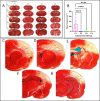This is a preprint.
Astrocyte-neuron lactate shuttle plays a pivotal role in sensory-based neuroprotection in a rat model of permanent middle cerebral artery occlusion
- PMID: 37034797
- PMCID: PMC10081351
- DOI: 10.21203/rs.3.rs-2698138/v1
Astrocyte-neuron lactate shuttle plays a pivotal role in sensory-based neuroprotection in a rat model of permanent middle cerebral artery occlusion
Update in
-
Astrocyte-neuron lactate shuttle plays a pivotal role in sensory-based neuroprotection in a rat model of permanent middle cerebral artery occlusion.Sci Rep. 2023 Aug 7;13(1):12799. doi: 10.1038/s41598-023-39574-9. Sci Rep. 2023. PMID: 37550353 Free PMC article.
Abstract
We have previously demonstrated protection from impending cortical stroke is achievable by sensory stimulation of the ischemic area in an adult rat model of permanent middle cerebral artery occlusion (pMCAo). We have further demonstrated that a major underpinning mechanism that is necessary for such protection is the system of collaterals among cerebral arteries that results in reperfusion of the MCA ischemic territory. However, since such collateral flow is weak, it may be necessary but not sufficient for protection and therefore we were seeking other complementary mechanisms that contribute to sensory-based protection. We hypothesized that astrocytes-to-neuron shuttle (ANLS) is another potential underpinning mechanism that could complement collateral flow in the protection process. Supporting our hypothesis, using functional imaging, pharmacological treatments, and postmortem histology, we show that ANLS has a pivotal role in sensory-based protection of cortex and therefor serves as the other supporting mechanism underpinning the protection process.
Conflict of interest statement
Competing interests (mandatory)
The author declares no competing interests.
Figures








Similar articles
-
Astrocyte-neuron lactate shuttle plays a pivotal role in sensory-based neuroprotection in a rat model of permanent middle cerebral artery occlusion.Sci Rep. 2023 Aug 7;13(1):12799. doi: 10.1038/s41598-023-39574-9. Sci Rep. 2023. PMID: 37550353 Free PMC article.
-
Spatiotemporal dynamics of pial collateral blood flow following permanent middle cerebral artery occlusion in a rat model of sensory-based protection: a Doppler optical coherence tomography study.Neurophotonics. 2019 Oct;6(4):045012. doi: 10.1117/1.NPh.6.4.045012. Epub 2019 Dec 10. Neurophotonics. 2019. PMID: 31824979 Free PMC article.
-
Sensory stimulation-based protection from impending stroke following MCA occlusion is correlated with desynchronization of widespread spontaneous local field potentials.Sci Rep. 2022 Feb 2;12(1):1744. doi: 10.1038/s41598-022-05604-1. Sci Rep. 2022. PMID: 35110588 Free PMC article.
-
Regional cerebral blood flow after occlusion of the middle cerebral artery.Acta Neurol Scand. 1986 Apr;73(4):321-37. doi: 10.1111/j.1600-0404.1986.tb03286.x. Acta Neurol Scand. 1986. PMID: 3524091 Review.
-
Expanding the concept of neuroprotection for acute ischemic stroke: The pivotal roles of reperfusion and the collateral circulation.Prog Neurobiol. 2016 Oct-Nov;145-146:46-77. doi: 10.1016/j.pneurobio.2016.09.002. Epub 2016 Sep 13. Prog Neurobiol. 2016. PMID: 27637159 Review.
References
Publication types
Grants and funding
LinkOut - more resources
Full Text Sources

